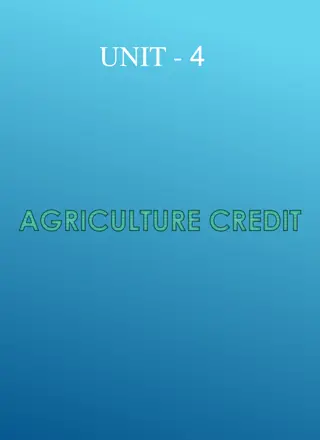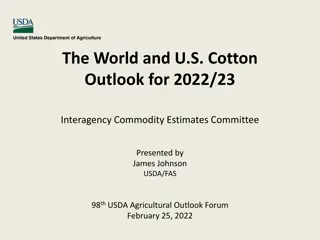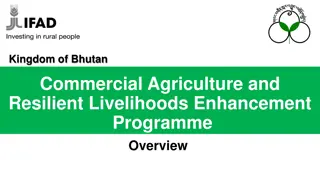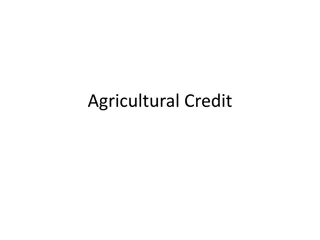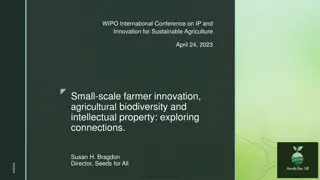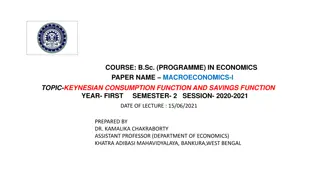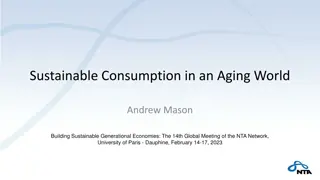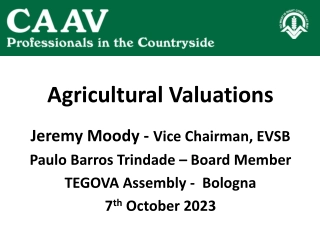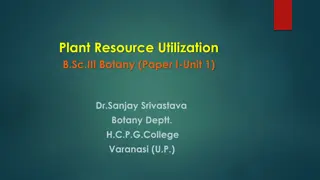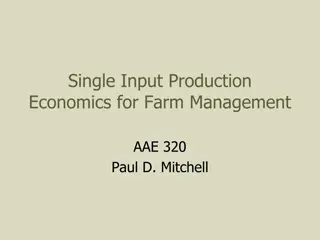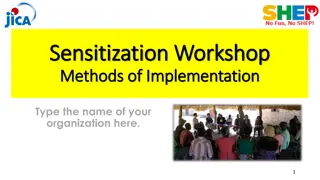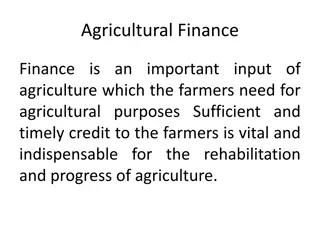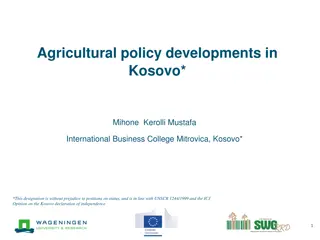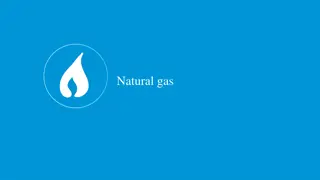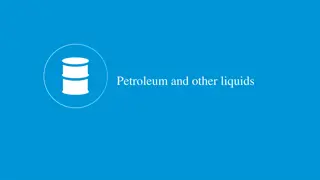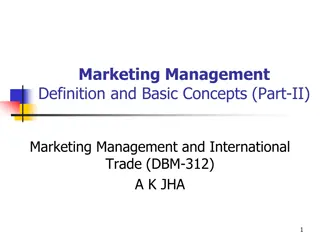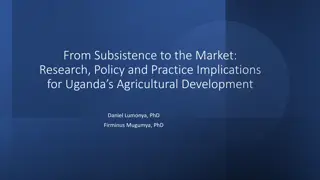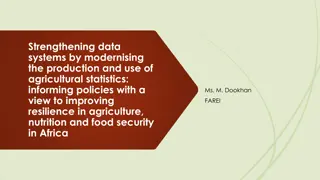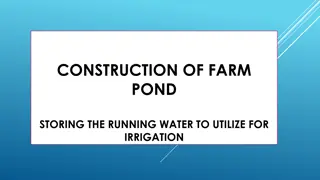Understanding Agricultural Marketing: From Production to Consumption
Civilization shifted mankind from a nomadic lifestyle to farming for food production. Agriculture markets play a crucial role in distributing food from production to consumption points globally. Marketing in agriculture involves all activities related to creating utility and satisfying needs through exchange processes. It encompasses the movement of farm-produced goods and raw materials to consumers, impacting farmers, middlemen, and consumers alike. The agricultural marketing system serves as a vital link between farms and non-farm sectors, facilitating the supply of farm inputs, processing industries, and policy development for marketing farm products.
Download Presentation

Please find below an Image/Link to download the presentation.
The content on the website is provided AS IS for your information and personal use only. It may not be sold, licensed, or shared on other websites without obtaining consent from the author. Download presentation by click this link. If you encounter any issues during the download, it is possible that the publisher has removed the file from their server.
E N D
Presentation Transcript
1 UNIT 5 AGRICULTURE MARKETS
1 CHAPTER 1 INTRODUCTION Mankind is considered the superior to the livingthings in the world. Civilization transformed that into producer of food and other basic requirements from the nomadic behaviour in which hunting and snatching were the way of life. Land cultivation and food production marked the beginning of civilization particularly in the riparian lands. Mother Nature has to offer Her blessings to satisfy the food needs of all living creatures. Land cultivation, otherwise known as farming is influenced by the behaviour of natural events like rainfall, drought, flood, storm and so on and so forth. Food production has its limitations and so all food
2 cannot be produced in all places. In other words, food production is restricted to specific locations where the soil, weather and moisture favour that activity. Nevertheless food produced has to be consumed worldwide by the human beings, animals, birds and others in need. A group of people specializing in food production and identified as farmers shoulder the noble responsibility of feeding the entire world. Hence there is no need to emphasis that food produced at specific places has to be distributed to other places of consumption. It is in this juncture, marketing plays its vital role.
3 point of production to the point of consumption. It includes all activities involved in the creation of time, place, form and possession utility. Philip Kotler has defined marketing as a human activity directed at satisfying the needs and wants through exchange process. American Marketing Association defined marketing as the performance of business activities that directs the flow of goods and services from producers to users. According to Thomsen, the study of agricultural marketing comprises all the operations, and the agencies conducting them, involved in the movement of farm produced foods, raw materials and their derivatives, such as
4 textiles, from the farms to the final consumers, and the effects of such operations on farmers, middlemen and consumers. Agricultural marketing is the study of all the activities, agencies and policies involved in the procurement of farm inputs by the farmers and the movement of agricultural products from the farms to the consumers. The agricultural marketing system is a link between the farm and the non- farm sectors. It includes the organization of agricultural raw materials supply to processing industries, the assessment of demand for farm inputs and raw materials, and the policy relating to the marketing of farm products
5 sector requires fertilizers, pesticides, farm equipments, machinery, diesel, electricity, packing material and repair services which are produced and supplied by the industry and non-farm enterprises. The expansion in the size of farm output stimulates forward linkages by providing surpluses of food and natural fibres which require transportation, storage, milling or processing, packaging and retailing to the consumers. These functions are obviously performed by non-farm enterprises. Further, if the increase in agricultural production is accompanied by a rise in real incomes of farm families, the demand of these families for non-farm consumer goods goes up as the proportion of income spent on non-food consumables and durables tends to rise with
6 the increase in real per capital income. Several industries, thus find new markets for their products in the farm sector. Agricultural marketing, therefore, can be defined as comprising of all activities involved in supply of farm inputs to the farmers and movement of agricultural products from the farms to the consumers. Agricultural marketing system includes the assessment of demand for farm-inputs and their supply, post-harvest handling of farm products, performance of various activities required in transferring farm products from farm gate to processing industries and/or to ultimate consumers, assessment of demand
7 importance of farm inputs improved seeds, fertilizers, insecticides and pesticides, farm machinery, implements and credit in the production of farm products has increased in recent decades. The new agricultural technology is input-responsive. Thus, the scope of agricultural marketing must include both product marketing and input marketing. In this book, the subject-matter of agricultural marketing has been dealt with; both from the theoretical and practical points of view. It covers what the system is, how it functions, and how the given methods or techniques may be modified to get the maximum benefits. Specially, the subject of agricultural marketing includes marketing functions, agencies, channels,
8 efficiency and costs, price spread and market integration, producer's surplus, marketing institutions, government policy and research, imports/exports of agricultural commodities and commodity and futures trading. New Role of Agricultural Marketing Agricultural marketing scenario in the country has undergone a sea-change over the last six decades owing to the increases in the supply of agricultural commodities and consequently in their marketed surpluses; increase in urbanization and income levels and thereby changes in the pattern of demand for farm products and their derivatives; slow and steady increase in the linkages with the overseas markets; and changes in the
9 There is an old English saying that two women and a goose may make a market. However, in common parlance, a market includes any place where persons assemble for the sale or purchase of commodities intended for satisfying human wants. Other terms used for describing markets in India are Haats, Painths, Shandies and Bazar. The word market in the economic sense carries a broad meaning. Some of the definitions of market are given below: 1 . A market is the sphere within which price determining forces operate. 2. A market is the area within which the forces of demand and supply converge to establish a single price.
10 3. The term market means not a particular market place in which things are bought and sold but the whole of any region in which buyers and sellers are in such a free intercourse with one another that the prices of the same goods tend to equality, easily and quickly. 4. Market means a social institution which performs activities and provides facilities for exchanging commodities between buyers and sellers. 5. Economically interpreted, the term market refers, not to a place but to a commodity or commodities and buyers and sellers who are in free
11 3. Price at which the commodity is transacted or exchanged 4. Business relationship or intercourse between buyers and sellers; and 5. Demarcation of area such as place, region, country or the whole world. Dimensions of a Market There are various dimensions of any specified market. These dimensions are: 1 . Location or place of operation 2. Area or coverage 3. Time span 4. Volume of transactions
12 5. Nature of transactions 6. Number of commodities 7. Degree of competition 8. Nature of commodities 9. Stage of marketing 10.Extent of public intervention 11.Type of population served 12.Accrual of marketing margins wholesalers. The bulk of the arrivals in these markets are from other markets. The produce in these markets is handled in large quantities. There are, therefore, specialized marketing agencies performing different marketing functions,
13 such as those of commission agents, brokers and weighmen in these markets. These markets help in assembling commodities from neighboring district/tehsil/state. (d) Terminal Markets: A terminal market is one where the produce is either finally disposed of to the consumers or processors, or assembled for export. In these markets, merchants are well organized and use modern methods of marketing. Commodity exchanges exist in these markets which provide facilities for forward trading in specific commodities. Such markets are located either in metropolitan cities or at seaports. Delhi, Mumbai,
14 Chennai, Bengaluru, Kolkata and Cochin are terminal markets In India for many commodities. (e) Seaboard Markets: Markets which are located near the seashore and are meant mainly for the import and/or export of goods are known as seaboard markets. These are generally seaport towns. Examples of these markets in India are Mumbai, Chennai, Kolkatta and Cochin (Kochi). 2. On the Basis of Area/Coverage
15 years many countries are moving towards a regime of liberal international trade in agricultural products like raw cotton, sugar, rice and wheat. It is expected that the international trade in such commodities will become free from many restrictions that exist now. 3. On the Basis of Time Span On this basis, markets are of the following types: (a) Short period Markets: The markets which are held only for a day or few hours are called short-period markets. The products dealt within these markets are of a highly perishable nature, such as fish, fresh vegetables, and liquid milk. In these markets, the prices of commodities are
16 governed mainly by the extent of demand for, rather than by the supply of, the commodity. Periodic Markets: The periodic markets are congregation of buyers and sellers at specified places either in villages, semi-urban areas or some parts of urban areas on specific days and time. Major commodities traded in these markets is the farm produce grown in the hinterlands. The periodic markets are held weekly, biweekly, fortnightly or monthly according to the local traditions. These are similar to 'spontaneous markets' in several developed countries. (b)
17 farm products in India can be classified as primary, secondary and terminal wholesale markets. The primary wholesale markets are in the nature of assembling centres located in and around producing regions. The transactions in primary wholesale markets take place mainly between farmers and traders. Secondary wholesale markets are generally located between primary wholesale and terminal markets. The transactions in these markets take place between primary wholesalers and traders of terminal market. The terminal markets are generally located at the large urban metropolitan cities or export centres catering to the large consuming population around them or in the overseas markets.
18 (b) Retail Markets: A retail market is one in which commodities are bought by and sold to the consumers as per their requirements. Transactions in these markets take place between retailers and consumers. The retailers purchase the goods from wholesale market and sell in small lots to the consumers in retail markets. These markets are very near to the consumers. The distinction between the wholesale and retain market can be made mainly on the basis of buyer. A retail market means that the buyers are generally ultimate consumers, whereas in the wholesale market the buyers can be wholesalers or retailers.
19 General Markets: A market in which all types of (a) commodities, such as foodgrains, oilseeds, fibre crops, gur, etc., are bought and sole is known as general market. These markets deal in a large number of commodities. Specialized Markets: A market in which transactions take place only in one or two commodities is known as a specialized market. For every group of commodities, separate markets exist. The examples of specialized markets are foodgrain markets, vegetable markets, wool market and cotton market. 7. On the Basis of Degree of Competition Each market can be placed on a continuous scale, starting from a perfectly competitive point to a pure (b)
20 monopoly or monopsony situation. Extreme forms are almost non-existent. Nevertheless, it is useful to know their characteristics. In addition to these two extremes, various midpoints of this continuum have been identified. On the basis of competition, markets may be classified into the following categories: (a) Perfect Markets: A perfect market is one in which the following conditions hold good: There is a large number of buyers and sellers; All the buyers and sellers in the market have perfect knowledge of demand, (i) (ii)
21 hypothetical price in a common market. The market situation in which there are only two buyers of a commodity is known as the duopsony market. Oligopoly Market: A market in which there are more than two but still a few sellers of a commodity is termed as an oligopoly market. A market having a few (more than two) buyers is known as oligopsony market. Monopolistic Competition: When a large number of sellers deal in heterogeneous and differentiated form of a commodity, the situation is called monopolistic competition. The difference IS made conspicuous by different trade marks on the product. Different prices prevail for the same basic product. Examples of (iii) (iv)
22 monopolistic competition faced by farmers may be drawn from the input markets. For example, they have to chose between various makes of insecticides, pumpsets, fertilizers and equipments. 8. On the Basis of Nature of Commodities On the basis of the type of goods dealt in, market may be classified into the following categories: (a) Commodity Markets: A market which deals in goods and raw materials,
23 Regulated Markets: These are those markets in (a) which business is done in accordance with the rules and regulations framed by the statutory market organization representing different sections involved in markets. The marketing costs in such markets are standardized and, marketing practices are regulated. Unregulated Markets: These are the markets in which business is conducted without any set rules and regulations. Traders frame the rules for the conduct of the business and run the market. These markets suffer from many ills, ranging from unstandardised charges for marketing functions to imperfections in the determination of prices. (b)
24 11. On the Basis of Type of Population Served On the basis of population served by a market, it can be classified as either urban or rural market. Urban Market: A market which serves mainly the population residing in an urban area is called an urban market. The nature and quantum of demand for agricultural products arising from the urban population is characterized as urban market for farm products. Rural Market: The word rural market usually refers to the demand originating the trade of some agricultural commodities like milk, fertilizers, sugarcane and sugar. In the case of marketing activities undertaken by producers or consumers co-operatives, the marketing margins are either negligible or shared amongst their (a) (b)
25 members. In some cases, farmers themselves work as sellers of their produce to the consumers. On the basis, the market can be (a) farmers markets, (b) cooperative markets or (c) general markets. It must be noted that each market or market place can be classified on the basis of the 12 criteria mentioned above. A 12-dimensional classification of markets is shown in Chart 1.1.
26 Chart: 1.112 Dimensional Classification of Markets ON THE BASIS OF LOCATION VILLAGE MARKETS PRIMARYMARKETS SECONDARY WHOLESALE MARKETS TERMINALMARKETS SEA-BOARD MARKETS LOCAL/VILLAGE MARKETS REGIONAL MARKETS NATIONAL MARKETS WORLD/INTERNATIONAL MARKETS ON THE BASIS OF AREA OR COVERAGE
27 ON THE BASIS OF TIME SPAN SHORT PERIOD MARKETS PERIODIC MARKETS LONG PERIOD MARKETS
28 COMPETITIVE MARKETS COMMODITY MARKETS CAPITAL MARKETS PRODUCING MARKETS CONSUMING MARKETS REGULATED MARKETS UN-REGULATED MARKETS ON THE BASIS OF NATURE OF COMMODITIES ON THE BASIS OF STAGE OF MARKETING ON THE BASIS OF EXTENT OF PUBLIC INTERVENTION
29 ON THE BASIS OF TYPE OF POPULATION SERVED ON THE BASIS OF MARKET FUNCTIONARIES URBAN MARKETS RURALMARKETS FARMERS MARKETS CO-OPERATIVE MARKETS GFNFRAI MARKFTS AND ACCRUALOFMARKETING
30 The agricultural marketing system plays a dual role in economic development in countries whose resources are primarily agricultural. Increasing demands for money with which to purchase other goods leads to increasing sensitivity to relative prices on the part of the producers, and specialization in the cultivation of those crops on which the returns are the greatest, subject to socio-cultural, ecological and economic constraints. It is the marketing system that transmits the crucial price signals. On the other hand, and in order to sustain the growth of the non- agricultural sector, resources have to be extracted from the agricultural sector physical resources to guarantee supplies of food and raw materials for the agro-industry and
31 financial resources for investment in nonfarm economy as well as for re-investment in agriculture. On the basis of IADP experience, Kiehl has shown that the "marketing problem" begins to emerge in the process of shifting from traditional to modern agriculture because of production surpluses generated by the shift. Indeed, the term modern agriculture implies a market- oriented agriculture. The scope for moving towards modern agriculture must include market dimensions if the momentum of production transformation is to be sustained. The mportance of agricultural marketing in economic development is revealed increased production is, therefore, very important, and this can be made possible only by streamlining the marketing system.
32 (iii) Widening of Markets An efficient and well-knot marketing system widens the market for the products by taking them to remote corners both within and outside the country, i.e., to areas far away from the production points. The widening of the market helps in increasing the demand on a continuous basis, and thereby guarantees a higher income to the producer. (iv) Growth of Agro-based Industries An improved and efficient system of agricultural marketing helps in the growth of agro-based industries and stimulates the overall development process of the economy. Many industries like cotton, sugar, edible oils, food
33 processing and jute depend on agriculture for the supply of raw materials. (v) Price Signals An efficient marketing system helps the farmers in planning their production in accordance with the needs of the economy. This work is carried out through transmitting price signals. population, reducing consumer food prices, earning more foreign exchange or eliminating economic waste has, therefore, to pay special attention to the development of an efficient marketing for food and agricultural products. (x) Creation of Utility
34 Marketing is productive, and is as necessary as the farm production. It is, in fact, a part of production itself, for production is complete only when the product reaches a place in the form and at the time required by the consumers. Marketing adds cost to the product, but, at the same time, it adds utilities to the product. The following four types of utilities of the product are created by marketing: Form Utility: The processing function adds form utility to the product by changing the raw material into a finished form. With this change, the product becomes more useful than it IS in the form in which it is produced by the farmer. For example, through processing, oilseeds are (a)
35 converted into oil, sugarcane into sugar, cotton into cloth and wheat into flour and bread. The processed forms are more useful than the original raw materials. Place Utility: The transportation function adds place utility to products by shifting them to a place of need from the place of plenty. Products command higher (b)





